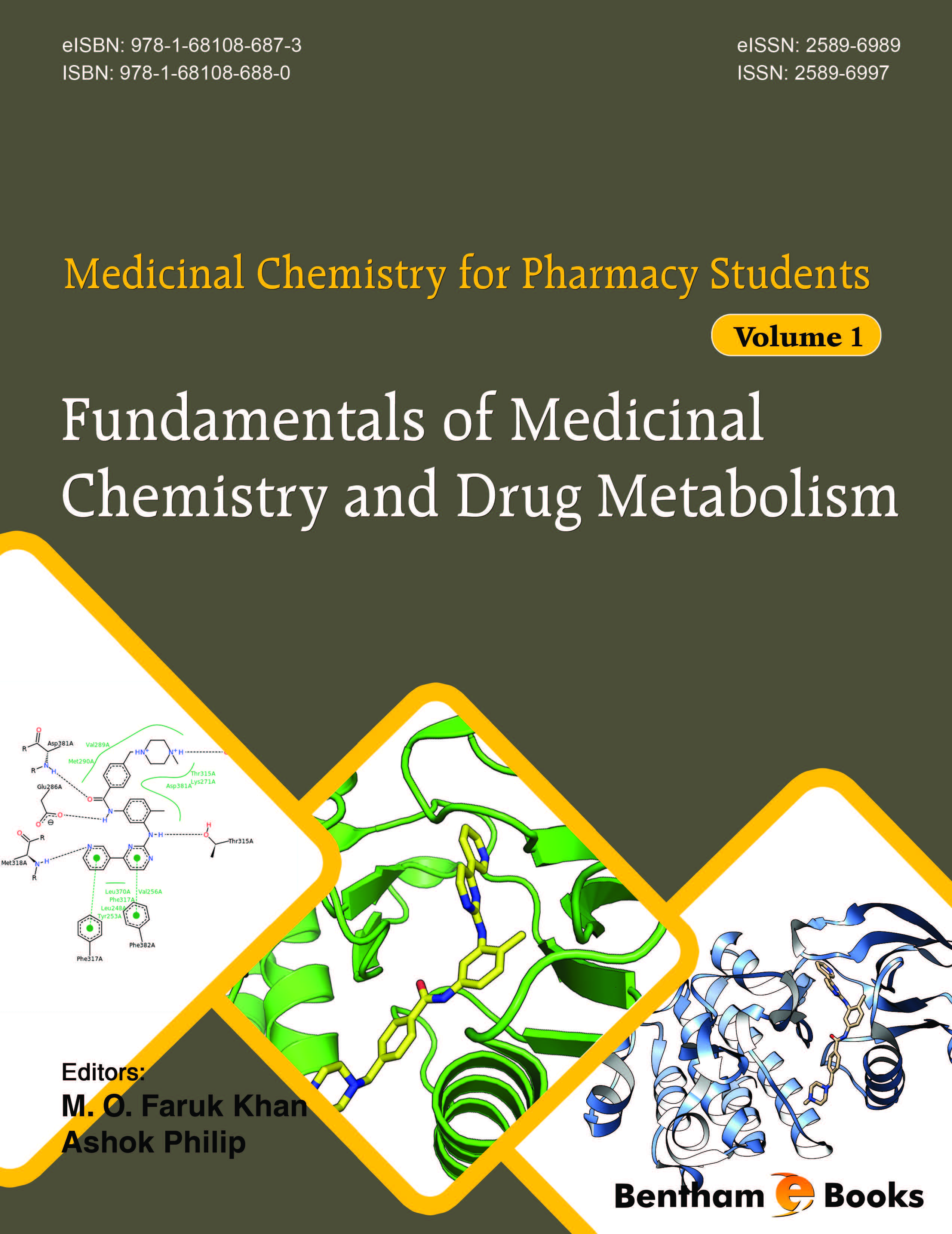This is the first volume of the 4-volume eBook series, “Medicinal Chemistry for Pharmacy Students”. The primary objective of this e-Book series is to educate Pharm-D students in the area of medicinal chemistry and serve as a reference guide to pharmacists on the aspects of chemical basis of drug action. A thorough discussion of key physicochemical parameters of therapeutic agents and how they affect the biochemical, pharmacological, and pharmacokinetic processes and clinical use of these agents is the primary focus of the whole book. The rationale for putting together an e-Book of this nature is to equip Pharm-D students with the scientific basis to competently evaluate, recommend and counsel patients and health care professionals regarding the safe, appropriate, and cost-effective use of medications.
This first volume of the series titled, “Fundamentals of Medicinal Chemistry and Drug Metabolism”, is comprised of 8 chapters focusing on basic background information to build a firm knowledge base of medicinal chemistry. It takes a succinct and conceptual approach to introduce important fundamental chemical concepts, required for a clear understanding of various facets of pharmacotherapeutic agents, drug metabolism and important biosynthetic pathways that are relevant to drug action.
Chapter 1 is designed to ensure that the students learn about the scope and importance of medicinal chemistry, in addition to some important definitions. This chapter is an introduction to the overall role of a pharmacist and to the significance of medicinal chemistry in pharmacy education. It discusses the role of the pharmacist, history of medicinal chemistry and intellectual domains of medicinal chemistry.
Chapter 2 includes a comprehensive discussion of the four major biomolecules: proteins, carbohydrates, lipids, nucleic acids and key heterocyclic ring systems. Organic functional groups present in drugs, and biomolecules are reviewed in this chapter. Additionally, heterocycles present in drugs and biomolecules are reviewed in this chapter.
Chapter 3 focuses on acid base chemistry and salt formation; a brief review of the concepts of acid-base chemistry including the Arrhenius, Brønsted-Lowry, and Lewis concepts of acids and bases. It also highlights the significance of salt formation in pharmaceutical products, factors that determine ionization, and acid-base strengths. The application of acid-conjugate base, base-conjugate acid and Henderson-Hasselbalch equation in pharmacy and drug action and bioavailability are also discussed. The interpretation of pH partition theory, its significance in drug pharmacokinetics, the purpose of salt formation with drug molecules and the acidity or basicity of the salts are illustrated in this chapter.
Chapter 4 covers solubility and lipid-water partition coefficient (LWPC) concepts in detail with specific drug examples. Hydrophilicity, hydrophobicity and lipophilicity of drugs, and their effect on solubility are discussed to enable the readers to predict the water or lipid solubility of drugs based on their chemical composition. Additionally, the chapter includes a discussion of the effects of partition coefficient on drug bioavailability and action.
Chapter 5 reviews the concepts of isosterism, stereochemical principles, and their application. An explanation of drugs’ spatial factors, and their influence on drug action including definitions of important stereochemical parameters are also included.
Chapter 6 is a brief review of the mechanisms of drug action and discusses drug receptor interactions critical for pharmacological responses of drugs. This chapter also discusses the theories of drug action that include: occupancy theory, rate theory, induced-fit theory, macromolecular perturbation theory, and occupation-activation theory of “two-state” model.
Chapter 7 provides a detailed account of drug metabolism, prodrugs and related terminology. It provides a comprehensive account of the fundamental concepts of drug metabolism, describes the significance of drug metabolism, key enzymes involved in the sites of drug metabolism, phase I and phase II metabolic pathways that include oxidation reduction hydrolysis, glucuronic acid conjugation, sulfate conjugation, conjugations with glycine and other amino acids, glutathione or mercapturic acid, acetylation, and methylation. This chapter also defines and differentiates between prodrug, soft drug and antedrugs and discusses their clinical significance.
Chapter 8 provides a brief review of biosynthetic pathways frequently targeted by pharmaceutical interventions. The biosynthetic pathways discussed in this chapter include: eicosanoid biosynthesis (prostaglandins, prostacyclins and leukotrienes), epinephrine and norepinephrine biosynthesis, folic acid biosynthesis, steroid biosynthesis (cholesterol, adrenocorticoids and sex hormones) and nucleic acid biosynthesis (purines and pyrimidines anabolism, catabolism and salvages).
The chapters in this volume are designed to guide the reader to review, integrate and apply medicinal chemistry concepts to the study of therapeutic agents that are the focus of subsequent volumes. All concepts are illustrated with diagrams or figures, with the keywords highlighted, bulleted or numbered. Wherever needed, special boxes and case studies are included. In addition, each chapter is reinforced with practice problems and answer sets. Special notations are highlighted using call-out boxes for visual effect. Tables and figures are used to augment the text as needed.
We would like to express our sincere gratitude to the contributing authors for their time and effort in completing this volume. We would also like to thank Bentham Science Publishers, particularly Ms. Fariya Zulfiqar (Assistant Manager Publications) for their support. We are confident that this volume of the eBook series will guide students and educators of pharmacy and related health professions worldwide.
M. O. Faruk Khan, Ph.D.
Marshall University School of Pharmacy,
Huntington, WV,
USA
&
Ashok Philip, Ph.D.
Union University College of Pharmacy,
Jackson, TN,
USA

